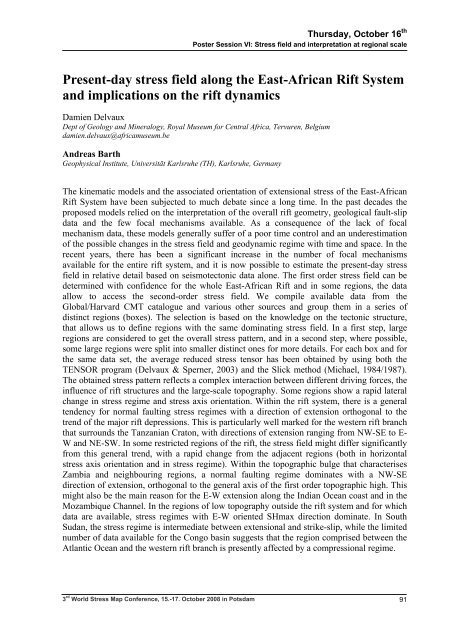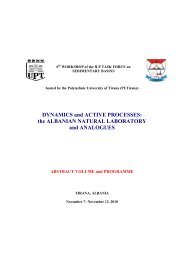World Stress Map Conference - International Lithosphere Program ...
World Stress Map Conference - International Lithosphere Program ...
World Stress Map Conference - International Lithosphere Program ...
You also want an ePaper? Increase the reach of your titles
YUMPU automatically turns print PDFs into web optimized ePapers that Google loves.
3 rd <strong>World</strong> <strong>Stress</strong> <strong>Map</strong> <strong>Conference</strong>, 15.-17. October 2008 in Potsdam<br />
Thursday, October 16 th<br />
Poster Session VI: <strong>Stress</strong> field and interpretation at regional scale<br />
Present-day stress field along the East-African Rift System<br />
and implications on the rift dynamics<br />
Damien Delvaux<br />
Dept of Geology and Mineralogy, Royal Museum for Central Africa, Tervuren, Belgium<br />
damien.delvaux@africamuseum.be<br />
Andreas Barth<br />
Geophysical Institute, Universität Karlsruhe (TH), Karlsruhe, Germany<br />
The kinematic models and the associated orientation of extensional stress of the East-African<br />
Rift System have been subjected to much debate since a long time. In the past decades the<br />
proposed models relied on the interpretation of the overall rift geometry, geological fault-slip<br />
data and the few focal mechanisms available. As a consequence of the lack of focal<br />
mechanism data, these models generally suffer of a poor time control and an underestimation<br />
of the possible changes in the stress field and geodynamic regime with time and space. In the<br />
recent years, there has been a significant increase in the number of focal mechanisms<br />
available for the entire rift system, and it is now possible to estimate the present-day stress<br />
field in relative detail based on seismotectonic data alone. The first order stress field can be<br />
determined with confidence for the whole East-African Rift and in some regions, the data<br />
allow to access the second-order stress field. We compile available data from the<br />
Global/Harvard CMT catalogue and various other sources and group them in a series of<br />
distinct regions (boxes). The selection is based on the knowledge on the tectonic structure,<br />
that allows us to define regions with the same dominating stress field. In a first step, large<br />
regions are considered to get the overall stress pattern, and in a second step, where possible,<br />
some large regions were split into smaller distinct ones for more details. For each box and for<br />
the same data set, the average reduced stress tensor has been obtained by using both the<br />
TENSOR program (Delvaux & Sperner, 2003) and the Slick method (Michael, 1984/1987).<br />
The obtained stress pattern reflects a complex interaction between different driving forces, the<br />
influence of rift structures and the large-scale topography. Some regions show a rapid lateral<br />
change in stress regime and stress axis orientation. Within the rift system, there is a general<br />
tendency for normal faulting stress regimes with a direction of extension orthogonal to the<br />
trend of the major rift depressions. This is particularly well marked for the western rift branch<br />
that surrounds the Tanzanian Craton, with directions of extension ranging from NW-SE to E-<br />
W and NE-SW. In some restricted regions of the rift, the stress field might differ significantly<br />
from this general trend, with a rapid change from the adjacent regions (both in horizontal<br />
stress axis orientation and in stress regime). Within the topographic bulge that characterises<br />
Zambia and neighbouring regions, a normal faulting regime dominates with a NW-SE<br />
direction of extension, orthogonal to the general axis of the first order topographic high. This<br />
might also be the main reason for the E-W extension along the Indian Ocean coast and in the<br />
Mozambique Channel. In the regions of low topography outside the rift system and for which<br />
data are available, stress regimes with E-W oriented SHmax direction dominate. In South<br />
Sudan, the stress regime is intermediate between extensional and strike-slip, while the limited<br />
number of data available for the Congo basin suggests that the region comprised between the<br />
Atlantic Ocean and the western rift branch is presently affected by a compressional regime.<br />
91




